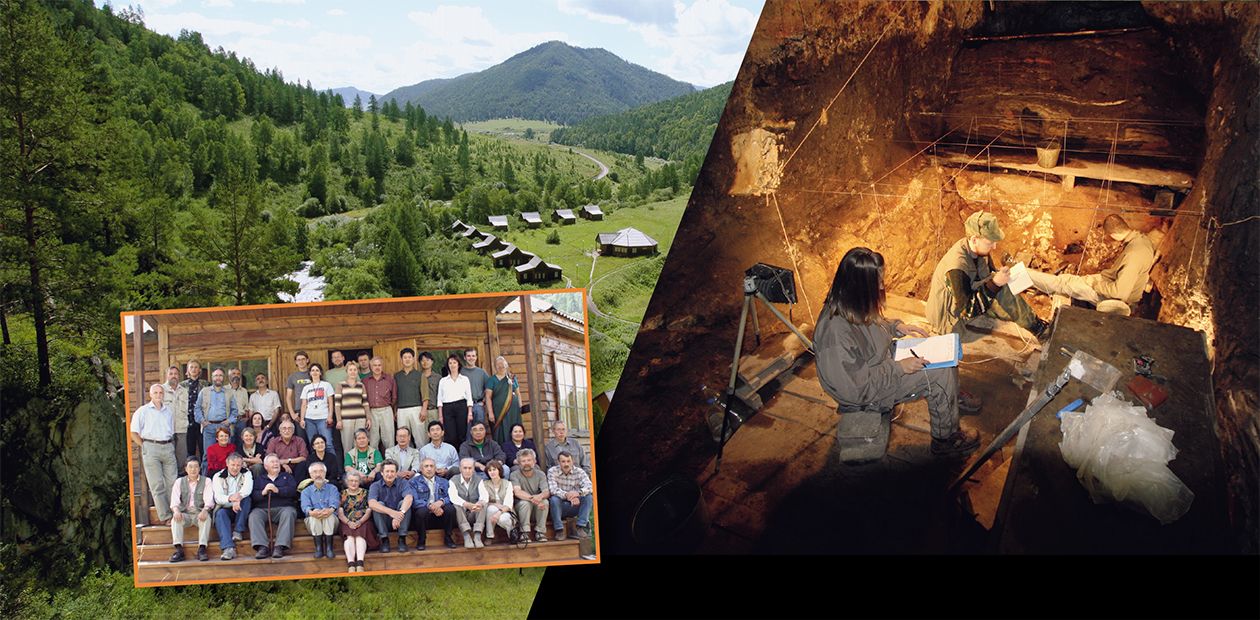The Paleolithic Childhood of the Altai
In late summer 2005, Paleolithic archaeologists from various countries of the world met in the valley of the Cherny Anui River in the Altai. The comfortable camp equipped with all modern conveniences which is a summer research camp of the Institute of Archaeology and Ethnography hosted a Symposium dedicated to important topics of human prehistory
These beautiful places, having been populated since the remote past, invited the Symposium participants for discussions. The picturesque and homey Anui valley contains many prehistoric sites including the widely known site in the Denisova Cave. Siberian archaeologists have been conducting research at the Denisova Cave for two decades already. Time goes, but paradoxically, the work to do has not become less. It is one of the laws of the process of basic research: the more tasks have been resolved, the more new questions arise. Discoveries broaden the horizons of scientific knowledge and necessitate the resolution of new, often unexpected, questions. Apparently, the discovery of the Karama Paleolithic site has become such a surprise for archaeologists.
“Presently we do not rush with establishing the precise dates for the site; however, our experience and intuition suggest that the site is really very old. According to our working hypothesis, the age of the site is around 400,000 years, while the earliest human habitation horizons can be dated back to as early as 800,000 years ago.” This is the opinion of Dr. Michael Shunkov, the head of the Denisova Cave Research Center.
The archaeologists rest their inferences on the analyses of stone tools from the site. The Karama artifacts have many features in common with the earliest pebble industries worldwide, in particular with the Oldowan culture from Africa originating nearly three million years ago. Thorough geological analyses of the soft sediments at the site as well as the analyses of pollen recovered from the thick sequence of deposits helped the researchers find the right way in the obscure past.
Michael Shunkov proceeds: “Foreign colleagues have even accused us of demureness. In their viewpoint, these artifacts are much older — about one million years old, possibly even older. Anyway, Karama is the oldest human settlement discovered so far in Russia. Moreover, the Karama evidence suggests that the history of the Altai, of Siberia and of Northern and Central Asia in general has become chronologically ‘longer’ at least by half a million years! It is one of the major results of our work presented at the Symposium.”
The findings from other Altai sites do not seem to look so impressive against the Karama evidence, which has suddenly got so old. However, this fact does not belittle their scientific value. In summer 2005, as well as in earlier seasons, interesting discoveries, some of them unique, became important contributions into world archaeology. The most recent finding from the Denisova cave became a real and well deserved present for archaeologists just before the beginning of the Symposium. A real pie piping hot out of the oven!
The implement made of soft gem stone, serpentine, mostly resembles a bracelet. It is not large in diameter and has an opening through which some additional elements can be attached to it through a leather string or a cord. From the point of view of modern people, this implement of our predecessors is quite common. However, for archaeologists, this item is unique because it is not typical of that period.
The ‘age’ of the lithological layer containing this artifact is about 50,000 years. Its surface demonstrates the signs of rather advanced technologies of stone working like sawing, drilling and polishing. Prior to this discovery, scholars were not aware of human ability to use such a variety of technological methods at early stages of the Upper Paleolithic. Due to the unusual technologies used in producing this implement, the ‘bracelet’ has become the crown of the collection of Paleolithic non-utilitarian implements, which also includes personal decorations and ritual objects. This large collection of the Institute of Archaeology and Ethnography comprises quite a number of interesting specimens.
This unique discovery is linked with one of the most important and basic issues of prehistory — the issue of a crossover from a Neanderthal to an anatomically modern man and from the Middle to Upper Paleolithic. Archaeological research of the most recent decades has shown that it was a complex transition, and the links between archaeological and anthropological aspects are not as straightforward as it was believed earlier. Judging by the evidence available, human evolution in its physical and ‘cultural’ aspects developed in different, sometimes isolated, ways; this process is not perfectly clear at the present stage of our knowledge.
The discovery of the unusual implement became a real sensation at the Symposium. At first our colleagues could hardly believe it. Today, Siberian archaeologists have started laying plans for the forthcoming field seasons and are looking forward to new discoveries in Siberia, the land so rich in wonders. Because, as you know, even the most extraordinary discoveriesw only broaden the horizons of scientific research…















